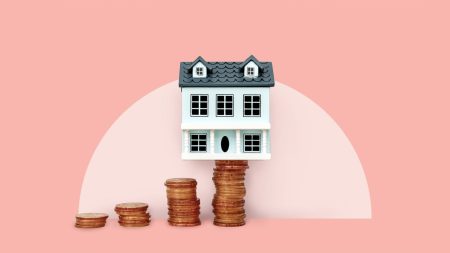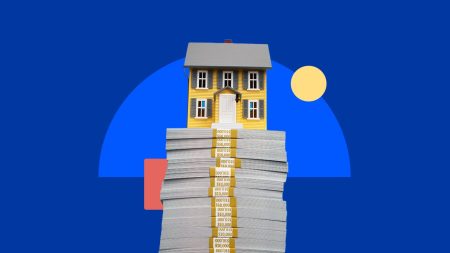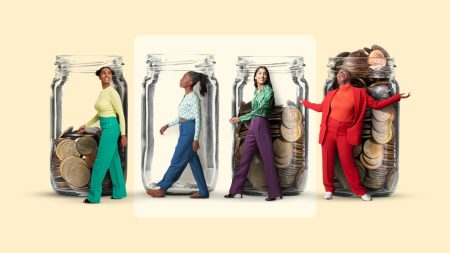Key takeaways
-
Multigenerational homes, in which multiple age groups live under one roof, have quadrupled between 1971 and 2021, involving nearly 60 million people.
- The rise is attributed to high housing costs, caregiving concerns, and social shifts in the U.S. population.
- Making a home multigenerational involves creating spaces that cater to all age groups, ensuring comfort, functionality, and some level of independence and privacy.
- There are several ways to finance a home for an extended family: home improvement loans, HELOCs/home equity loans, jumbo mortgages and construction loans.
After being married for three years, Tom and Merielle Lupfer were ready to buy a home in Northern New Jersey. But the market wasn’t ready for them. By the time the couple – both public school teachers — began looking, “Starter homes were priced out of being starter homes,” says Tom. “They were so expensive.”
They found a fixer-upper that, with some hard work, would work. But when Merielle’s parents saw the state of its disrepair, they thought it would be a bad idea. Instead, they suggested the pair move into their 1957 split-level ranch home with them.
“Pretty quickly, we decided, this sounds great,” says Tom. “We knew it would come with its own series of challenges, but the advantages would outweigh the disadvantages.” Fifteen years and twin daughters later, “it’s hard to think anything about our lives now that would be possible if we tried to buy that fixer-upper in 2010,” says Merielle.
Turns out the Lupfer family was ahead of the curve. Once a relic of 19th-century agrarian-economy days, multigenerational homes—in which several age groups live under the same roof—are making a big comeback. In fact, this way of living has quadrupled between 1971 and 2021, involving nearly 60 million people or 18 percent of the U.S. population, according to a Pew Research Center analysis of the latest U.S. Census Bureau data.
It’s a trend rooted in economics but also changing cultural norms. Why is it happening, and what are families doing to make the multigenerational living arrangement work?
Why are more generations living together?
More people are choosing to live in multigenerational homes for a variety of reasons. Not surprisingly, the top ones relate to finances.
The high cost of housing
“In many metro areas, housing has become more expensive over the decades,” says Richard Fry, senior economist at Pew Research Center. But, thanks to the pandemic, the cost of buying a home really skyrocketed in recent years: both purchase prices themselves and the cost to fund a purchase (mortgage interest rates, that is). Add to that a shortage of homes for sale, largely due to lags in home construction. Low inventory means fewer available homes, especially affordable ones — since starter homes have been low on builders’ priority lists.
In short, homeownership is more unaffordable than in just about any other time in U.S. history – not just buying a home but keeping it up. The squeeze affects all ages. “Young families oftentimes aren’t able to buy their own homes,” explains Donna Butts, executive director of Generations United, a Washington D.C.-based non-profit focused on intergenerational collaboration initiatives. “Then there are also older adults on limited income that are trying to maintain a house, but they may not have the income to maintain it anymore.”
Caregiving concerns and costs
Another motive for the growth in multigenerational living: caregiving for elderly family members. In fact, the second most common reason for buying a multigenerational home is to take care of aging parents, the National Association of Realtors (NAR)’s “2025 Home Buyers and Sellers Generational Trends Report” found (cost savings was the first). The need has become increasingly pressing, with the swelling of the ranks of seniors – many of whom want to age in place in their residences.
“Families increasingly want to care for and support one another in a home setting as loved ones age, but the financial burden can certainly be cost-prohibitive for some. This became more pronounced during the pandemic, with the early spread of COVID-19 in nursing homes,” says Jessica Lautz, NAR deputy chief economist and vice president of research.
But the trend has continued, especially given the increase in long-term care and other medical costs. While families came together because of a need during COVID, “they stayed together by choice because they found that it worked for them and for members of their family,” says Butts.
Social changes
Owning a home of one’s own is a key part of the American Dream, but America may be a bit of an outlier in this regard. In many other countries and cultures, multigenerational households are quite common, if not the norm. Today, within the U.S., the growth of ethnic groups with this tradition – such as Hispanics and Asians, along with Blacks — is fueling its growth here, according to a Pew Research Center analysis: “The rise in the multigenerational family household population is linked to the changing makeup of the overall U.S. population.”
Lupe Luna’s story reflects this cultural influence. When Lupe’s husband lost his job in 2009, she valiantly tried to handle household expenses solely with her income as a police department office coordinator. But it became too much, and in 2012, the couple made the difficult decision to surrender their house in a short sale. To the rescue: Lupe’s parents, who warmly welcomed their daughter and son-in-law into their four-bedroom, two-bathroom 1952 San Francisco Bay Area home.
“It was embarrassing — after all these years, you can’t make it on your own,” Lupe recalls. “But they were understanding.” Nine years later, Lupe’s unemployed adult daughter joined the household, putting three generations of her family under one roof.
Lupe Luna’s San Francisco Bay Area three-generational home
“What has helped is our culture. It’s acceptable to have other generations living with you,” says Lupe, who emigrated with her parents and siblings in the 1960s from Mexico — where both of her parents had grown up in extended-family households. “When we moved in, we had not lived together since I got married and that was a long time. Still, the transition went rather smoothly. I am really fortunate and blessed.”
Not leaving the nest
The rise in multigenerational households reflect the fact that today’s younger generation — the twentysomethings — seem to be slower to reach the milestones of adult life. “They’re staying in school longer. They’re marrying later. They’re getting out and forming their own households at a later age,” says Fry. “They’re also less likely to be setting up their own households and instead continue to live in the home they grew up in.” In fact, 25-to-29-year olds are the age group most likely to be living with multiple generations, according to the Pew Research Center.
How to make a home multigenerational
Whether you’re buying a new home or upgrading an existing one, turning a property into a multigenerational home is all about creating a space that works for everyone.
Start thinking about everyone who will be living there (aging parents, middle-aged adults, children or all three) and figure out what they will need to feel comfortable and able to function, while maintaining some independence and privacy. That might mean adding a bathroom, converting a den or carving out separate living quarters. The Lupfers, for example, revamped the lower level of the house – a walk-out basement — into a little suite for her parents to occupy.
Lupe’s family invested in some aging-in-place modifications to accommodate the elders and their limitations, such as replacing the cracked concrete patio to make it easier to navigate with a walker, and making the bathroom wheelchair accessible.
“Families increasingly want to care for and support one another in a home setting as loved ones age, but the financial burden can certainly be cost-prohibitive for some.”
— Jessica Lautz, NAR deputy chief economist and vice president of research
Financing the renovations
Your first step is figuring out how to finance the project. Here are some of your options and how they stack up against each other:
| Loan type | How it works | Best for | What to know |
| Home improvement loan | Unsecured personal loan | Smaller or simpler remodeling and repair projects | Quick funding, but typically has higher interest rates and fees |
| HELOC/Home Equity Loan | Borrow against the ownership stake in your home | Larger, longer-term upgrades, additions or accessory dwelling units (ADUs) | Your home is collateral, but you typically need at least a 15%-20% equity stake |
| Home renovation loan | Combination mortgage and loan | Buying a fixer-upper or rehabbing current home | Less-stringent borrower criteria, but substantial size and term restrictions |
| Jumbo mortgage | Mortgage for high-value homes | Buying a new multigenerational home outright | Higher loan limits that vary depending on where you live, but typically has stricter borrowing criteria |
| Construction loan | Short-term financing, paid out in stages | Building a home | Necessary for new builds; typically has higher rates but can be converted to traditional mortgage |
Life in a multigenerational household
Although a multigenerational household involves family, it’s also a business arrangement. More people in the multigenerational home means more people are able to contribute to maintenance and regular household expenses, like mortgage payments, property taxes or renovations. Among the wage-earners, it’s important to come up with ground rules on who pays for what.
When Lupe moved in, she told her parents she would pay the gas, electric, telephone and internet bills. Later on, she started paying for the groceries and split the costs for additions and modifications with her mother.
Caregiving discussions are also essential in multigenerational households, either for young children (don’t assume grandparents will be built-in babysitters) or senior adults. Lupe’s role has become that of a caregiver for her 88-year-old mother, who is blind. She also helped care for her father before he passed away.
Thinking back on giving up her own house to live with family, it was in a way “a blessing, because my parents also needed help,” says Lupe. “Maybe if they were much younger, it wouldn’t have worked out that way.”
And don’t forget to think long-term—especially when it comes to the legal side of things. What happens when one or both of the home’s current owners passes away? Will the other household members want to stay in the home? If so, you might want to consider adding them to the home title or creating a joint-ownership agreement, or setting up provisions in your will to ensure they can afford it. You might also see if there are any tax or financial advantages to adding them to the mortgage.
Some consider multigenerational living like an early inheritance. Merielle, an only child, recalls a discussion in which her parents explained their rationale for having Tom and her move in. “The house is all we got [to leave you]. When we’re not here anymore, it’s going to be your problem one way or another,” they said. So “you can start living in it now, fixing it up and doing what you want to do with it, with the understanding that down the line, you’re going to have to do something with it.”
The future of multigenerational living
Housing affordability is a big reason behind the multigenerational housing movement. But that doesn’t mean it won’t become a lasting part of how Americans live today. “Some builders have said the highest demand is [for homes for] multigenerational households,” says Butts. “They’re versatile. That extra space can be used as a rental unit,” for example, when it’s no longer needed for family members.
Homes that house extended families are “also driven by changing dynamics,” says Lautz. “It’s driven by baby boomers who are aging, who want to age in a different way, who want their location to be different than perhaps generations of the past.”
For Merielle, it’s about building mutual support and strengthening familial bonds – and, in a sense, carrying on a familial tradition. The home she grew up and lives in now is also the home in which her mother grew up: Her parents (Merielle’s grandparents) were its original owners. After they moved to a farm in upstate New York, it became her parents’ home – though often shared with the grandfolks on increasingly extended visits.
Will family history keep repeating itself? Merielle is open. “If four generations of women in my family living in this house is as far as this goes, then that’s a pretty good run,” she says. “Maybe this isn’t the house I’m going to live in the rest of my life, but I recognize what a beautiful thing it could be if it is. If I have the opportunity to give my children the choice like I had, with no pressure and expectation to carry on that legacy if they want to, that would be quite a thing.”
Read the full article here












